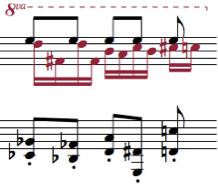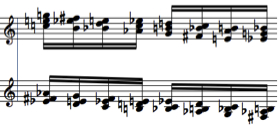The first movement can be divided into two sections that are linked by a piano cadenza. The first part introduces some of the main ideas of the symphony and the second part is a complex juxtaposition of cells which repeat in a ruthless, mechanical fashion. While the first part is important because of the presentation of two cyclic themes, this post is mostly concerned with the construction of the second part.
PART 1
We also hear the contrasting "Flower Theme" played gently by two clarinets.
A virtuosic piano cadenza leads into part 2.
PART 2
Pretty crazy, huh? It is important to understand that this section is just a series of different talas repeated. In a way, Messiaen is acting like a watchmaker. He carefully crafts each cell, puts them together, and lets them run on their own. Let's look at each of the different talas that contribute to this "machine-gone-haywire" sound.
Note: For the diagrams in this section, one minor (thin) grid line is equal to one sixteenth note. Since it is in 2/4 time and there are eight minor grid lines per major (thick) grid line, each major grid line represents one measure.
 |
| My copy of the score (with annotations I made for preparing this little write-up) showing the first two pages of part 2 of the first movement. Click on image to enlarge. |
Cell 1: Woodwinds
Instruments: 2 oboes, English horn, 2 clarinets in Bb, 1 bass clarinet in BbThe rhythm of cell 1 is the Hindu rhythm cycle Lakskmica (each small green block is one rhythm cycle), played with a cycle of 14 dense chords based off of mode 6.4 (each large red block is one chord cycle).
 |
| Cell 1, played by woodwinds with dense chords. Click on image to enlarge. |
A chord cycle of 14 chords (numbered in diagram) is placed on the rhythm cycle of 4 notes (also numbered in diagram). Notice what happens on the 4th green block -- the chord cycle begins again, but this time it starts on the 3rd note of the rhythm cycle. This is because 14 cannot be divided by 4 without a remainder. After the chord cycle repeats a second time, we can see that the next note (not shown). This happens after 7 complete rhythm cycles and 2 complete chord cycles -- 28 notes total. This isn't surprising because 28 is the least common multiple of 4 and 14.
Cell 2: Strings
Instruments: 2nd violins (divisi), violas (divisi)The rhythm of cell 2 is the Hindu rhythm cycle Ragavardhana (each small blue block is one rhythm cycle), played with a cycle of 13 chords based off of mode 4.4 (each large red block is one chord cycle).
| Cell 2, played by strings with dense chords. Click on image to enlarge. |
This is pretty much the same story as cell 1, except the least common multiple is larger so it takes the chord and rhythm cycles longer to re-synchronize.
Cell 3: Side Drum
In this cell, Messiaen uses his love of non-retrogradable rhythms. Simply put, a non-retrogradable rhythm is a rhythm which reads the same left-to-right as it does. This is the rhythmic equivalent of palindromic words such as "wow", or phrases such as "Rise to vote, sir."He creates a rhythmic cell constructed by the juxtaposition of four non-retrogradable sub-cells. Each of the four sub-cells has a center (a "nucleus") which is accented (played louder than the other notes).
 | |
| The four sub-cells used to construct cell 3. Notice how each sub-cell can be symmetrically divided about a central axis. Click on image to enlarge. |
| Cell 3, which is just the four sub-cells from above juxtaposed. Click on image to enlarge. |
Cell 4: Chinese Cymbal
Historically, composers have often used percussion to keep a steady beat. Perhaps in a more "classical" symphony a percussionist would be instructed to strike the cymbal at regular intervals -- say, every 12 sixteenth notes.This happens rarely in Messiaen's music. In this section, the Chinese cymbal initially plays a value of 17 sixteenth notes. Instead of continuing to play at this interval throughout the section, he diminishes the value of each note by one sixteenth note each time it sounds. Thus, the next note has a duration of 16 sixteenth notes, followed by 15 sixteenth notes, etc. The value is reduced until the note has a duration of 7 sixteenth notes. At this point he begins to augment each value (adding one sixteenth note) until the original duration of 17 sixteenth notes is reached. He continues to go back and forth between 17 sixteenth notes and 7 sixteenth notes throughout the entire section. Formally, he refers to this as a scale of chromatic durations.
| A diagram showing the expansion and contraction of the Chinese cymbal part. Click on image to enlarge. |
Cell 5: Makeshift "Indonesian Gamelan" Ensemble
Instruments: Piccolo, 2 flutes, 2 bassoons, tuba, celesta, glockenspiel, vibraphone, solo piano, ondes-Martinot, 1st violins, cellos, bassesLike his French predecessor Claude Debussy, Messiaen was intrigued by the exotic, metallic sounds of Indonesian Gamelan ensembles. While Debussy generally limited himself to using their harmonies, Messiaen goes further and actually mimics the timbre of the ensemble. Celesta, glockenspiel, vibraphone, and right-hand solo piano play in unison to seemingly create a sound that is as "metallic" as possible. He does choose to keep a steady tempo here by using eighth notes in the bassoons, left-hand solo piano, cellos, and basses. Furthermore, he adds a quiet yet unnerving "rumbling" in the extreme lower register of the ondes-Martinot.
 |
| The melody and accompaniment in cell 5 (the top staff is in treble clef and the bottom staff is in bass clef). A single cycle (shown above) consists of 5 eighth notes. |
This cell is very different from what we have seen so far because it is repeated and halted unpredictably. There doesn't seem to be any formulaic idea behind it.
Cell 6: Brass and Piano
Instruments: 4 French horns, piccolo trumpet in D, 3 trumpets in C, cornet, 2 trombones, maracas, woodblock, tubular bells, solo pianoConsisting of sudden brass interjections followed by descents on unusual scales, it appears that the purpose of cell 6 is to abruptly halt cell 5. This cell contains 4 main elements -- a sharp brass chord (accompanied by woodblock), a series of sixteenth notes with the same chord on solo piano with a crescendo (accompanied by maracas), an intriguingly-harmonized descending scale in the brass (accompanied by tubular bells and one woodblock strike), and the same descending scale in the solo piano (accompanied by tubular bells and two woodblock strikes).
Brass interjections:
Piano/maracas sixteenth notes:
The scale and harmonies are all based on mode 3.1 (click here for more information on how these harmonies are constructed).
 |
| The descending scale played by the brass and solo piano. |
Although the basic elements remain the same throughout the section, each time it appears the elements seem to occur a different number of times or switch order (i.e. notice how there are only two sharp brass chords on its first appearance, whereas there are three on its second).
This series of repetitions comes to an abrupt halt and a short coda brings back the "Statue Theme" amidst terrifying, clashing dissonances. The movement ends with a dramatic sweep from the ondes-Martinot's highest register to its lowest, four cymbal strikes, and a loud bass drum thud.
Note: In this movement, all audio recordings either ones that I generated using Finale or from Hannu Lintu's recent (and outstanding) recording of the piece with the Finnish Radio Symphony Orchestra.
No comments:
Post a Comment